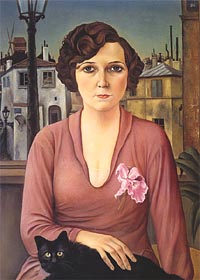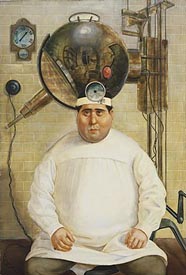|
One of the important factors that led to
much of the diversity seen in the art of Neue Sachlichkeit
was demographics. Berlin at the time was the fourth largest city in
the world. But Germany was a country with a number of large cities and
thriving cultural centers. Art was able to develop and flourish
regionally. And as the 1920's progressed, the movement became broad-based.
It included many individual styles and well as local groups. At the same time, the lack of any
single dominant cultural
center, in contrast with Paris for France, at least initially may
have contributed to
a lack of attention and recognition by the art community outside Germany.
Expressionist art
returned within
 Germany in the
early Postwar period like an unmanaged garden after a long winter.
Initially a new generation of artists began to pour out work,
benefiting from a recovery in the market. As Expressionism was
supposed to emphasize spiritual values, many of its supporters
became critical of this commercialism . Soon there was a call for a
"new naturalism", and by 1919 the pressures against Expressionism began to build. The result was the abandonment of
the Expressionist and Modernist styles by groups of artists in
various parts of the country. In
contrast with Italy, where there were strong
classical traditions for artists to fall back on, Germany had fewer
indigenous art traditions to build on, once Expressionism was
set aside. Most notable the Germans admired the Nazarenes and
several artists
of the German Romantic movement (i.e., Caspar David Friedrich,
Arnold Boecklin). At the same time, many German artists of this time
also followed developments in Italy, especially through the journal Valori
Plastici, which covered artists in Il
Novecento Italiano and Pittura Metafiscia (Giorgio de Chirico,
Carlo Carra & Giorgio Morandi). It is important to note that there
was a strong affinity between German artists and Italian art, both
classical and contemporary. A chart
showing some influences on various Post-Expressionist artists is
available here. Germany in the
early Postwar period like an unmanaged garden after a long winter.
Initially a new generation of artists began to pour out work,
benefiting from a recovery in the market. As Expressionism was
supposed to emphasize spiritual values, many of its supporters
became critical of this commercialism . Soon there was a call for a
"new naturalism", and by 1919 the pressures against Expressionism began to build. The result was the abandonment of
the Expressionist and Modernist styles by groups of artists in
various parts of the country. In
contrast with Italy, where there were strong
classical traditions for artists to fall back on, Germany had fewer
indigenous art traditions to build on, once Expressionism was
set aside. Most notable the Germans admired the Nazarenes and
several artists
of the German Romantic movement (i.e., Caspar David Friedrich,
Arnold Boecklin). At the same time, many German artists of this time
also followed developments in Italy, especially through the journal Valori
Plastici, which covered artists in Il
Novecento Italiano and Pittura Metafiscia (Giorgio de Chirico,
Carlo Carra & Giorgio Morandi). It is important to note that there
was a strong affinity between German artists and Italian art, both
classical and contemporary. A chart
showing some influences on various Post-Expressionist artists is
available here.
The years 1920-1925 saw the
concurrent development of the core groups of Neue Sachlichkeit art,
in Berlin, Munich, Dresden, Cologne and Hannover. These were years
of economic and political instability. The counter-movement to
Expressionism was fostered by a considerable attention in art
periodicals, variously referred to as Post-Expressionism, or "Neo Realism", or "Neo
Naturalism", or "Magic Realism" or "Magic Naturalism" .
Ultimately, with the opening of Gustav Hartlaub's exhibition in
Hannover during June 1925, under the banner "Die Neue
Sachlichkeit", the movement obtained broad recognition and the name
that would be applied to the movement thereafter.
Art critic Emilio Bertonati characterized the art of the Neue Sachlichkeit
by breaking it down into four
groups. Works by individual artists may seem to fall into different groups,
but this chart provides basic categorization.
Protest (socially critical):
Georg Grosz, Rudolf Schlichter,
Otto Dix, Otto Griebel, Barthel
Gilles, Karl Hubbuch, Adolf Uzarski
Geometry (Simplified or constructive):
Heinrich Hoerle, Anton Raderscheidt, Carl
Grossberg
Poetic (or rustic):
Georg Schrimpf, Alexander Kanoldt,
Carlo Mense, Heinrich Maria Davringhausen, Reinhold Nagale
Magic (naturalistic or detailed):
Christian Schad, Georg Scholz,
Franz Radziwill,
Rudolf Dischinger,
Wilhelm Schnarrenberger, Gert Wollheim,
Grethe Juergens, Franz Lenk
In
these groupings the more typical works of Magic Realism
 generally occurred
within the last two groups.
Paintings by Christian Shad and Franz Radziwill are most often cited
by writers, yet Radziwill was slow in moving from Expressionism and
eventually drifted toward Surrealism . Some pieces by Georg Scholz,
Alexander Kanoldt and
Carlo Mense
are representative. The somewhat
cynical work of Rudolf Schlichter and
of Otto Dix in many cases display some
characteristics of Magic Realism .Dix, through his intense study of the old masters, was able
to achieve varied and stunning results as the decade progressed. It was Dix's intense passion for life as expressed in his art that
has left us one of the strongest artistic legacies during this period. generally occurred
within the last two groups.
Paintings by Christian Shad and Franz Radziwill are most often cited
by writers, yet Radziwill was slow in moving from Expressionism and
eventually drifted toward Surrealism . Some pieces by Georg Scholz,
Alexander Kanoldt and
Carlo Mense
are representative. The somewhat
cynical work of Rudolf Schlichter and
of Otto Dix in many cases display some
characteristics of Magic Realism .Dix, through his intense study of the old masters, was able
to achieve varied and stunning results as the decade progressed. It was Dix's intense passion for life as expressed in his art that
has left us one of the strongest artistic legacies during this period.
Two important types
of Magic Realism developed during this period, and both types were
later adapted by artists in other countries. One type was a
dreamlike, even toy-like, miniature style, with its roots in Rousseau
or in
early de Chirico,
filled with mystery or strangeness. Often this approach uses unusual
viewpoints and juxtapositions, or a skewed or restricted palette. Varying
degrees of stylization may be introduced. The second
type was a more
naturalistic style which selectively used highly defined details,
which has multiple points of interest throughout the work. This
type was rooted in the art of the Flemish and German masters, as
well as in contemporary currents in Italy. In addition to style, the
artist's choices of pictorial elements and subject matter contribute
to give a work of Magic Realism the power to mesmerize.
Our
discussion continues as Magic Realism is brought to other countries.
The topics include its development in other European
countries and subsequently its importation in the Americas.

Neue Sachlichkeit Gallery
European Magic
Realism Gallery
American Magic Realism
Gallery
Chapter 1 Magic Realism Introduction
Chapter 2 - Roots of Magic Realism
Chapter 4 - Surrealism vs Magic Realism
Chapter 5 - Magic Realism in other European
countries
Chapter 6 - Magic Realism in the Americas
(1)
Chapter 7 - Magic Realism in the Americas (2)
Chapter 8 - Contemporary Magic Realism
Chapter 9 - The Future of Magic Realism
Email:
dreams@tendreams.org
|